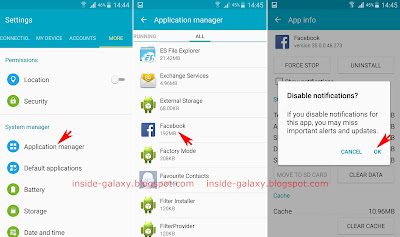For some reason, you'll probably want to block notifications of a certain app so that you won't be disturbed by notifications from this app. As the example, if you block Facebook app notifications, your phone won't show notifications on the status bar and play a sound or vibrate when receiving notifications from this app.
How to block notifications of an app?
Basically, there are some methods available that can be used to block app notifications, but as the example, we'll try to block notifications of the Facebook app by using two different methods: from the app manager menu and from the app notifications menu(you can use this method if your Samsung Galaxy S4 has been updated to
Android 5.0.1 Lollipop).
Method #1: From the App manager menu
- On any screen, swipe down the top of the screen to open up the notifications panel and then tap
 at the top right to go to the settings menu.
at the top right to go to the settings menu.
- Tap More tab.
- Tap Application manager.
- Swipe the screen from the right to the left to access the All tab. All installed apps will be displayed here.
- Scroll down the screen to find Facebook app, and then tap it.
- Clear the checkbox in the left side of the Show notifications option to disable it.
- A pop up window will appear to tell you that you may miss important alerts or updates if you disable app notifications. Tap OK button to continue.
- The notifications of the Facebook app has been disabled and all notifications from this app will be blocked.
Method #2: From the App notifications menu
- On any screen, swipe down the top of the screen to open up the notifications panel and then tap
 at the top right to go to the settings menu.
at the top right to go to the settings menu.
- Tap My device tab.
- Tap Sounds and notifications.
- Scroll the screen to the very bottom.
- Tap Application notifications.
- Scroll down the screen to find Facebook, and then tap it.
- Slide the ON/OFF switch next to Block to the right to enable it. The switch turns green when it's enabled.
- The notifications of the Facebook app has been disabled and all notifications from this app will be blocked.
 at the bottom of the screen.
at the bottom of the screen.






